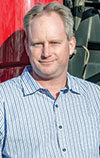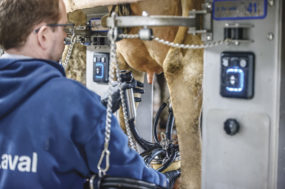As many hay producers and operators know, one of the most challenging aspects of baling hay is determining its quality and relative feed value (RFV). The feed value of hay crops like alfalfa can vary tremendously, making it difficult to determine the amount of hay needed in a balanced ration to be fed to livestock.
The standard practice of conducting tests on random hay samples to determine its quality presents many challenges, including accuracy, the difficulty of tracking the hay through the feeding process and the ability to effectively adjust rations.
Many hay operators, like Gary McManus of Lakeview, Oregon, are looking to new baler technologies to help them identify RFV quickly and accurately to ultimately increase profits. McManus utilizes a baler system – which enables him to measure the RFV of his crops in real-time as it is being baled – and store and download the values for later use.
The key to accurately measuring RFV is determining bale weight. The system McManus uses on his farm employs an algorithm and three different sensors to measure the alfalfa leaf-to-stem ratio. As the leaf content increases, so does the weight. After taking a sample, the system is able to correlate the weight of acid detergent fiber and neutral detergent fiber to predict RFV.
The lower the acid detergent fiber and neutral detergent fiber, the higher the RFV. The system ultimately garners more consistent nutrition and performance of animals at a lower production cost.
In conjunction with the RFV system, McManus also uses a bale tagger that enables him to put the RFV number on each bale. With this information easily identifiable, he can effortlessly sort his bales by nutritional value. The tagger applies an RFID tag on each bale that holds all the crucial information for that bale. The data is then read back with a hand scanner.
“I almost feel spoiled being able to sort and tag my bales so efficiently,” McManus says. “I’m able to know what is what – sort the whole pivot into one pile, quarter pivot into another. For example, because the hay I bale from the south side of the farm is different from the north side, I can program in the variations and get a different tag for each bale.
I can look at which bales have the lowest quality and make sure they don’t take up space in my barn. Not only does it allow me to tag it with the RFV, but I can include date and time, moisture level and total digestible nutrients. It’s a game-changer.”
The technology utilized in hay operations is evolving – and not just in RFV technology. Sensors added to the top or in the bale chamber allow customers to determine crop moisture with large square balers sooner rather than later in the process, making it possible to apply crop preservatives based on crop moisture to maximize feed value while minimizing input costs.
Today, onboard moisture sensing through microwave sensors is offered in the pre-charge chamber for increased speed and accuracy.
Dry matter technology
As we look toward the future, we’re going to start seeing advancements in precision technology for cutting products and the ability to predict the digestibility of the hay. At the current state, hay operators don’t have a way to measure before and after dry matter losses, and if we can’t measure it, we can’t manage for it. This is one of the reasons there is so much variability.
In the future, it would be great to measure dry matter as the crop is cut, re-measure it again as it is baled and compare those two measurements to better understand how much dry matter is being lost. For example, operators could make bales at various moisture settings and then show the measurable difference in RFV.
This would ultimately lead to a change in behaviors – enabling them to utilize real-time electronic data off the baler to determine when to rake at the optimal time. In addition, precision technology also helps when it comes to sprayers; operators can measure the chlorophyll level of the alfalfa plant and vary the application accordingly. Scouting tools like the drone can determine whether a field is getting enough nutrients or being attacked by insects.
Baler automation
While baler automation is currently in its infancy, it’s certain to pick up speed over the next decade. Today, some tractors and round balers communicate together to enable operators to automate the baling process, allowing it to make, wrap and dump the bale without operator intervention.
The entire process can cut down on operator interventions by two-thirds, ensuring comfort and longevity in the fields, which is particularly important for today’s aging producers.
On some large square balers, operators are able to create uniform bale lengths by setting the machine to slice control. This enables the baler to communicate to the tractor to vary the ground speed based on the volume of crop coming into its pre-charge chamber, keeping a consistent flake thickness for consistent bale weights, which increases the operation efficiency.
Keep in mind: For hay operations, usage consistency is key in its ability to add value. In the future, we will see even more automation in the operation with enhanced capability of the baler and tractor communicating and working together to improve efficiency and profitability.
Between the technologies currently available and the technology coming down the pike, it’s certainly an exciting time to be a hay producer. Whether we’re talking about RFV or tractor and baler automation, rapidly changing agricultural technology is creating efficiencies across the farm enabling today’s producers to feed tomorrow’s growing world. ![]()
PHOTO: Hay-making technology continues to develop to help producers create a better product. Photo by Lynn Jaynes.
Curt Hoffman is a hay and forage crop packaging marketing manager with New Holland Agriculture. Email Curt Hoffman.






